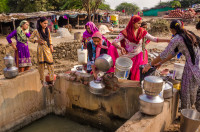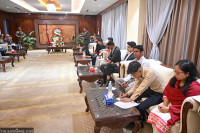Opinion
Womb on rent
The government should formulate a law related to surrogacy to prevent the exploitation of women’s bodies
Dr Minani Gurung
Surrogacy is a process through which people who want babies pay other women to deliver their child. There are two methods to do so: traditional and gestational. In the traditional method, the sperm is artificially inseminated in the surrogate mother’s womb who goes on to deliver baby on behalf of the couple. In the second, relatively advanced gestational method, the sperm and the egg from a father and mother is first fertilised through in-vitro fertilisation and the embryo is then placed inside the surrogate mother’s womb.
Benefits and hazards
While surrogacy is a boon for infertile couples, it could pose many social and medical risks to the surrogate mothers. Along with the social stigma attached to it, surrogate mothers face many health risks induced by pregnancy such as pregnancy-induced hypertension, gestational diabetes, preeclampsia/eclampsia, anemia, thromboembolic diseases, postpartum depression and psychosis. To use one’s body as a vessel to carry someone else’s child is not simply physically torturous but also an emotionally draining process. Thereby, many countries in the world have either banned surrogacy, strictly regulate it or have made it very expensive.
Surrogacy also raises many cultural, social, economic and political questions. To begin with, surrogate mothers have been found to be merely treated as baby-producing machines in many cases. The baby is the product and until the product is delivered, the surrogates are either cared for or claimed to be taken care of. Once the baby is born, the surrogate mothers are simply forgotten about. So in the absence of properly defined laws, there is a real danger that surrogacies could encourage women trafickking. Such women might simply be forced to undergo the process for money.
Surrogacy in Nepal
The issue of surrogacy in Nepal first came to the fore in March 2011 after a case was filed at the Kathmandu District Court over the property rights of a baby born through a surrogate mother. The court ruled that the child is equally entitled to inherit parental property. Of late, the issue is back into limelight as the country has turned into a hub for surrogacy in the absence of rules and weak regulatory mechanisms. In particular, after India tightened its rules on commercial surrogacy, foreigners seeking such services have started trickling into Nepal.
Last year, the Cabinet made a decision to allow surrogacy in Nepal with the intention of promoting medical tourism in the country. The decision allowed foreigners to have surrogate babies as long as the surrogate mother was also a foreigner. But in recent times, many cases of Nepali surrogate mothers have surfaced. To make matters worse, these women have been found to be exploited by unscrupulous middle-men and their male relatives to carry and deliver babies for foreigners.
Need for a law
The absence of laws to regulate surrogacy services in Nepal makes matters worse. But as the Supreme Court recently issued an interim order to close down surrogacy services in the country until the government brings in laws to oversee it, not all is lost for surrogate mothers. The government should use this as an opportunity to formulate a law which addresses the concerns of the surrogate mothers instead of merely treating them as ‘income generators’. The law should provide them will with all the required medical facilities and ensure that surrogacy is not run like a business.
The law should ensure that surrogate mothers are treated humanely and that they are not exploited. Furthermore, it must introduce provisions that do not allow parents to discard the baby after the surrogate mother delivers it.
The new law should create a government agency to regulate assisted reproductive technology clinics and ensure that they meet certain standard of cleanliness and medical expertise and abide by a code of ethics. Clinics should be required to provide services such as counseling to the parents and the surrogates. The clinics and hospitals should maintain detailed records of both the parties. The surrogates’ compensation should be standardised; the medicines and food should be made available to them free of cost and that their emotional and psychological needs should be addressed. In conclusion, the process of using a fertile woman’s body to bear somebody else’s child has to be done in a legal and humane manner. The government must realise that commercial surrogacy could develop into a heartless, inhuman business if is not regulated properly. It should act fast and bring in the required law before this currently illegal business turns into a hideous crime that exploits women.
Gurung is a medical doctor




 19.12°C Kathmandu
19.12°C Kathmandu










